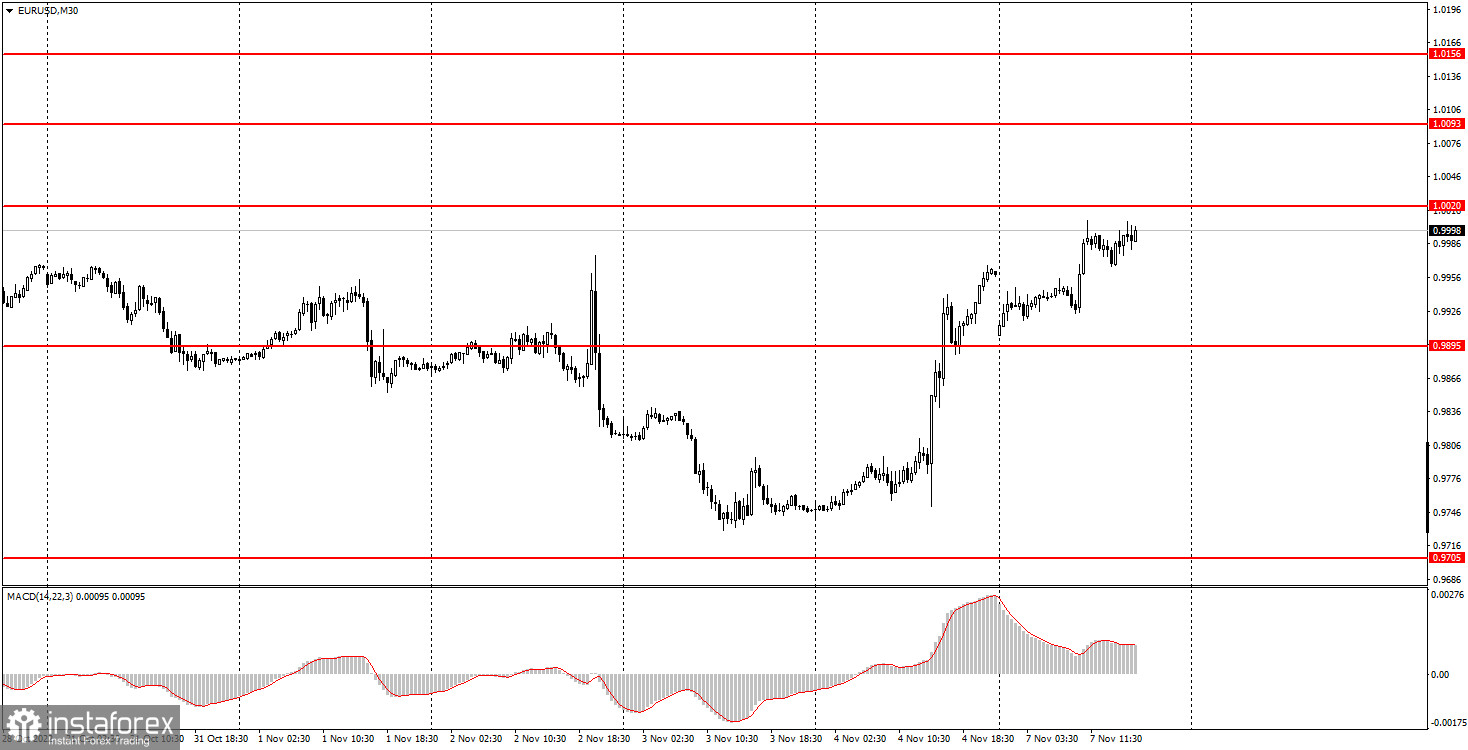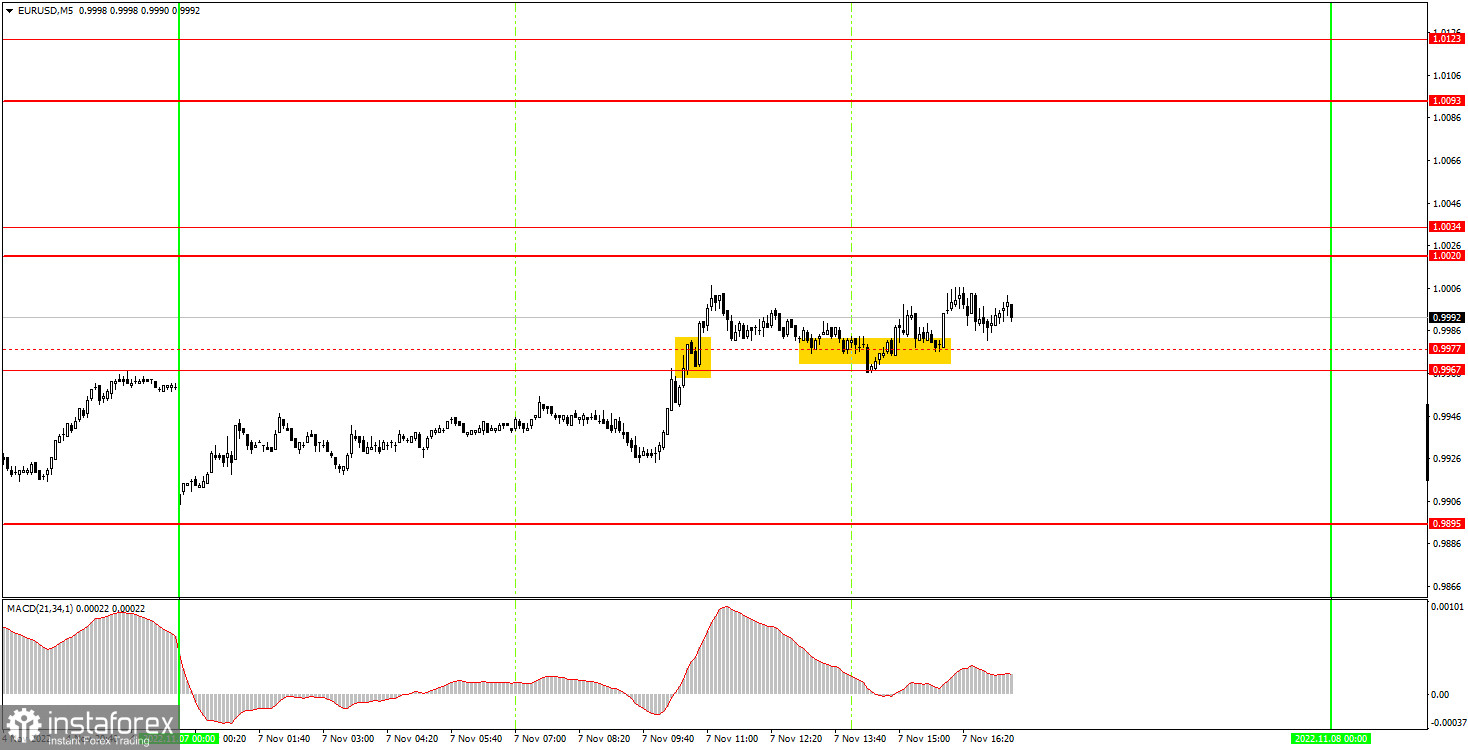Analysis of Monday's deals:
30M chart of the EUR/USD pair

The EUR/USD currency pair continued to trade with an upward slope on Monday. We have already said in previous articles that we do not consider the euro's growth on Friday to be logical. However, the market decided otherwise, so on Monday, with an absolutely empty news calendar, we witnessed the euro rise. It was not too strong, but still had a place to be. Since there were no important events on Monday, the market could trade only on the basis of the fundamental and macroeconomic background of the end of last week. Or on "bare" technique. We are leaning towards the first option and draw your attention to the fact that the movement on the higher time frames (4-hour, for example) is now very similar to a "swing" with a slight upward slope. We believe that this is a sign of the bulls' uncertainty, who still do not understand why they should buy euros? There are certain reasons, of course, but they now look and sound not entirely convincing. For example, the European Central Bank rate may start catching up with the Federal Reserve rate in the next few months and the gap between them will narrow. There is no trend line or channel on the 30-minute timeframe right now, so there are no trend references either.
5M chart of the EUR/USD pair

There were few trading signals on the 5-minute timeframe today, and the movement was not the best. By and large, during the day we saw only one upward move in the middle of the European session. After that, the price moved mostly sideways. It was not possible to catch the beginning of the movement, so we had to be content with two mediocre buy signals. Both formed near the level of 0.9977, which, following the results of Monday, was transformed into the level of 0.9967. First, the pair overcame 0.9977 and went up 18 points, and then bounced off it and went up again 18 points. Therefore, in both cases, novice traders could set Stop Loss to breakeven. On the second, you could even get a few points of profit, since it had to be closed manually in the late afternoon, but this is clearly not the level of profit that you expect when entering the market.
How to trade on Tuesday:
The pair continues to move up on the 30-minute timeframe, but there is a feeling that it will not last long. There is no pronounced trend now, and on the higher time frames everything looks as if the pair intends to go into a "swing" or into a flat. We still do not see how the euro can show growth in the medium term. Neither on the basis of "technique", nor on the basis of "foundation", nor on the basis of macroeconomics with geopolitics. On the 5-minute TF on Tuesday , it is recommended to trade at the levels of 0.9709, 0.9756, 0.9807, 0.9895, 0.9967, 1.0020-1.0034, 1.0093, 1.0123, 1.0156. When passing 15 points in the right direction, you should set Stop Loss to breakeven. The European Union will publish a report on retail sales, but there's nothing in the US. We do not believe that this report will affect the movement of the euro/dollar pair, but a small reaction may still follow.
Basic rules of the trading system:
1) The signal strength is calculated by the time it took to form the signal (bounce or overcome the level). The less time it took, the stronger the signal.
2) If two or more positions were opened near a certain level based on false signals (which did not trigger Take Profit or the nearest target level), then all subsequent signals from this level should be ignored.
3) In a flat, any pair can form a lot of false signals or not form them at all. But in any case, at the first signs of a flat, it is better to stop trading.
4) Trade positions are opened in the time period between the beginning of the European session and until the middle of the US one, when all positions must be closed manually.
5) On the 30-minute TF, using signals from the MACD indicator, you can trade only if there is good volatility and a trend, which is confirmed by a trend line or a trend channel.
6) If two levels are located too close to each other (from 5 to 15 points), then they should be considered as an area of support or resistance.
On the chart:
Support and Resistance Levels are the Levels that serve as targets when buying or selling the pair. You can place Take Profit near these levels.
Red lines are the channels or trend lines that display the current trend and show in which direction it is better to trade now.
The MACD indicator (14,22,3) consists of a histogram and a signal line. When they cross, this is a signal to enter the market. It is recommended to use this indicator in combination with trend lines (channels and trend lines).
Important speeches and reports (always contained in the news calendar) can greatly influence the movement of a currency pair. Therefore, during their exit, it is recommended to trade as carefully as possible or exit the market in order to avoid a sharp price reversal against the previous movement.
Beginners on Forex should remember that not every single trade has to be profitable. The development of a clear strategy and money management are the key to success in trading over a long period of time.
 English
English 
 Русский
Русский Bahasa Indonesia
Bahasa Indonesia Bahasa Malay
Bahasa Malay ไทย
ไทย Español
Español Deutsch
Deutsch Български
Български Français
Français Tiếng Việt
Tiếng Việt 中文
中文 বাংলা
বাংলা हिन्दी
हिन्दी Čeština
Čeština Українська
Українська Română
Română

